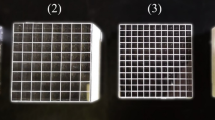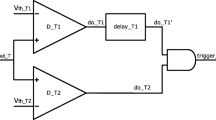Abstract
We developed a time-based single-transmission-line readout method for time-of-flight positron emission tomography (PET) detectors. The 2D position of a silicon photomultiplier (SiPM) array was encoded in the upper and lower widths of a specially prepared L-shaped tag pulse followed by the original scintillation signal. A PET detector setup was configured using a 4 × 4 array of LSO crystals optically coupled one-to-one to a 4 × 4 SiPM array. Two pulse width modulator circuits were employed per SiPM anode signal channel and a total of 32 width-modulated digital pulses were summed and merged with a delayed common-cathode signal. The final output was analyzed using timestamps crossing two-level threshold voltages. All 16 crystals were clearly separated on a positioning map. The average energy and coincidence time resolutions were 15.0 ± 1.1% and 288.7 ± 29.3 ps after proper correction process, respectively. A 3D position decoding capability was also shown by the remarkable discrimination performance in a phoswich PET detector setup (LSO and LGSO), resulting from well-preserved scintillation signals. The proposed method enables a time-based single-channel readout with 3D gamma ray interaction position decoding capability without compromising on detector performance. This method provides gamma ray energy and arrival time information as well as 2D and depthwise interaction positions of the phoswich detectors through one channel readout. Thus, channels can be reduced by at least 4–5 times compared to typically employed charge-sharing-based position multiplexing method; this significantly reduces the burden of data acquisition on the PET system.








Similar content being viewed by others
References
Lee JS, et al. Geiger-mode avalanche photodiodes for PET/MRI. In: Iniewski K, editor., et al., Electronics for radiation detection. Boca Raton: CRC Press; 2010. p. 179–200.
Kwon SI, et al. Development of small-animal PET prototype using silicon photomultiplier (SiPM): initial results of phantom and animal imaging studies. J Nucl Med. 2011;52(4):572–9.
Yamaya T, et al. A SiPM-based isotropic-3D PET detector X’tal cube with a three-dimensional array of 1 mm3 crystals. Phys Med Biol. 2011;56(21):6793.
Roncali E, et al. Application of silicon photomultipliers to positron emission tomography. Ann Biomed Eng. 2011;39(4):1358–77.
Ferri A, et al. Performance of FBK high-density SiPM technology coupled to Ce:LYSO and Ce:GAGG for TOF-PET. Phys Med Biol. 2014;59(4):869.
Casey M, et al. A next generation SiPM based PET/CT system with improved time and spatial resolution. J. Nucl. Med. 2017;58:1332S.
Lee MS, et al. Prototype pre-clinical PET scanner with depth-of-interaction measurements using single-layer crystal array and single-ended readout. Phys Med Biol. 2017;62(10):3983.
Hsu DF, et al. Studies of a next-generation silicon-photomultiplier–based time-of-flight PET/CT system. J Nucl Med. 2017;58(9):1511–8.
Won JY, et al. Development and initial results of a brain PET insert for simultaneous 7-tesla PET/MRI using an FPGA-only signal digitization method. IEEE Trans Med Imaging. 2021;40(6):1579–90.
Cates JW, et al. Analytical calculation of the lower bound on timing resolution for PET scintillation detectors comprising high-aspect-ratio crystal elements. Phys Med Biol. 2015;60(13):5141.
Nemallapudi MV, et al. Sub-100 ps coincidence time resolution for positron emission tomography with LSO:Ce co-doped with Ca. Phys Med Biol. 2015;60(12):4635.
Gundacker S, et al. Measurement of intrinsic rise times for various L (Y) SO and LuAG scintillators with a general study of prompt photons to achieve 10 ps in TOF-PET. Phys Med Biol. 2016;61(7):2802.
Gundacker S, et al. State of the art timing in TOF-PET detectors with LuAG, GAGG and L (Y) SO scintillators of various sizes coupled to FBK-SiPMs. J Instrum. 2016;11(08):P08008.
Brunner SE, et al. BGO as a hybrid scintillator/Cherenkov radiator for cost-effective time-of-flight PET. Phys Med Biol. 2017;62(11):4421.
Cates JW, et al. Improved single photon time resolution for analog SiPMs with front end readout that reduces influence of electronic noise. Phys Med Biol. 2018;63(18):185022.
Dey S, et al. A CMOS ASIC design for SiPM arrays. In: IEEE nuclear science symposium conference record. 2011. p. 732–737.
Dolinsky S, et al. Timing resolution performance comparison for fast and standard outputs of SensL SiPM. In: 2013 IEEE nuclear science symposium and medical imaging conference. NSS/MIC; 2013. pp 1–6.
Brunner SE, et al. A comprehensive characterization of the time resolution of the Philips digital photon counter. J Instrum. 2016;11(11):P11004.
Yoshino M, et al. Development and performance evaluation of time-over-threshold based digital PET (TODPET2) scanner using SiPM/Ce: GAGG-arrays for non-invasive measurement of blood RI concentrations. J Instrum. 2017;12(02):C02028.
Chen Y, et al. DIET: a multi-channel SiPM readout ASIC for TOF-PET with individual energy and timing digitizer. J Instrum. 2018;13(07):07023.
Shimazoe K, et al. Development of simultaneous PET and Compton imaging using GAGG-SiPM based pixel detectors. Nucl Instrum Methods Phys Res Sect A Accel Spectrom Detect Assoc Equip. 2020;954:161499.
Olcott PD, et al. Compact readout electronics for position sensitive photomultiplier tubes. IEEE Trans Nucl Sci. 2005;52(1):21–7.
Popov V, et al. A novel readout concept for multianode photomultiplier tubes with pad matrix anode layout. Nucl Instrum Methods Phys Res Sect A Accel Spectrom Detect Assoc Equip. 2006;567(1):319–22.
Ito M, et al. Continuous depth-of-interaction measurement in a single-layer pixelated crystal array using a single-ended readout. Phys Med Biol. 2013;58(5):1269.
Dey S, et al. A row-column summing readout architecture for SiPM based PET imaging systems. In: 2013 IEEE nuclear science symposium and medical imaging conference. NSS/MIC; 2013. pp. 1–5.
Kwon SI, et al. Signal encoding method for a time-of-flight PET detector using a silicon photomultiplier array. Nucl Instrum Methods Phys Res Sect A Accel Spectrom Detect Assoc Equip. 2014;761:39–45.
Stolin AV, et al. Evaluation of imaging modules based on SensL array SB-8 for nuclear medicine applications. IEEE Trans Nucl Sci. 2014;61(5):2433–8.
Siegel S, et al. Simple charge division readouts for imaging scintillator arrays using a multi-channel PMT. IEEE Trans Nucl Sci. 1996;43(3):1634–41.
Goertzen AL, et al. Design and performance of a resistor multiplexing readout circuit for a SiPM detector. IEEE Trans Nucl Sci. 2013;60(3):1541–9.
Ko GB, et al. Development of a front-end analog circuit for multi-channel SiPM readout and performance verification for various PET detector designs. Nucl Instrum Methods Phys Res Sect A Accel Spectrom Detect Assoc Equip. 2013;703:38–44.
Downie E, et al. Investigation of analog charge multiplexing schemes for SiPM based PET block detectors. Phys Med Biol. 2013;58(11):3943.
Olcott PD, et al. Cross-strip multiplexed electro-optical coupled scintillation detector for integrated PET/MRI. IEEE Trans Nucl Sci. 2013;60(5):3198–204.
Powolny F, et al. A novel time-based readout scheme for a combined PET-CT detector using APDs. IEEE Trans Nucl Sci. 2008;55(5):2465–74.
Orita T, et al. A new pulse width signal processing with delay-line and non-linear circuit (for ToT). Nucl Instrum Methods Phys Res Sect A Accel Spectrom Detect Assoc Equip. 2011;648:S24–7.
Olcott PD, et al. Pulse width modulation: a novel readout scheme for high energy photon detection. In: 2008 IEEE nuclear science symposium conference record. 2008. pp. 4530–4535.
Schmand M, et al. Performance results of a new DOI detector block for a high resolution PET-LSO research tomograph HRRT. IEEE Trans Nucl Sci. 1998;45(6):3000–6.
Pepin CM, et al. Properties of LYSO and recent LSO scintillators for phoswich PET detectors. IEEE Trans Nucl Sci. 2004;51(3):789–95.
Schmall JP, et al. Characterization of stacked-crystal PET detector designs for measurement of both TOF and DOI. Phys Med Biol. 2015;60(9):3549.
Yamamoto S, et al. Timing performance measurements of Si-PM-based LGSO phoswich detectors. Nucl Instrum Methods Phys Res Sect A Accel Spectrom Detect Assoc Equip. 2016;821:101–8.
Fujiwara T, et al. Multi-level time-over-threshold method for energy resolving multi-channel systems. IEEE Trans Nucl Sci. 2010;57(5):2545–8.
Parl C, et al. Fast charge to pulse width converter for monolith PET detector. IEEE Trans Nucl Sci. 2012;59(5):1809–14.
Shimazoe K, et al. Dynamic time over threshold method. IEEE Trans Nucl Sci. 2012;59(6):3213–7.
Bieniosek MF, et al. Compact pulse width modulation circuitry for silicon photomultiplier readout. Phys Med Biol. 2013;58(15):5049.
Grant AM, et al. A new dual threshold time-over-threshold circuit for fast timing in PET. Phys Med Biol. 2014;59(13):3421.
Yonggang W, et al. A linear time-over-threshold digitizing scheme and its 64-channel DAQ prototype design on FPGA for a continuous crystal PET detector. IEEE Trans Nucl Sci. 2014;61(1):99–106.
Ko GB, et al. Time-based signal sampling using sawtooth-shaped threshold. Phys Med Biol. 2019;64(12):125020.
Ota R. Development of dual time-over-threshold method for estimation of scintillation decay time and energy. In: Proceedings of the second international symposium on radiation detectors and their uses. ISRD; 2018. p. 011012.
Ko GB, et al. Single transmission-line readout method for silicon photomultiplier based time-of-flight and depth-of-interaction PET. Phys Med Biol. 2017;62(6):2194.
**e S, et al. Methods to compensate the time walk errors in timing measurements for PET detectors. IEEE Trans Radiat Plasma Med Sci. 2020;4(5):555–62.
Prout DL, et al. A digital phoswich detector using time-over-threshold for depth of interaction in PET. Phys Med Biol. 2020;65(24):245017.
Du H, et al. Continuous depth-of-interaction encoding using phosphor-coated scintillators. Phys Med Biol. 2009;54(6):1757.
Berg E, et al. A combined time-of-flight and depth-of-interaction detector for total-body positron emission tomography. Med Phys. 2016;43(2):939–50.
Han SK, et al. Simulation study of side-by-side phoswich PET detector configuration for providing high spatial resolution of< 0.4 mm. In: 2018 Joint 10th international conference on soft computing and intelligent systems (SCIS) and 19th international symposium on advanced intelligent systems (ISIS). IEEE; 2018. pp. 346–349.
Wei Q, et al. A side-by-side LYSO/GAGG phoswich detector aiming for SPECT imaging. Nucl Instrum Methods Phys Res Sect A Accel Spectrom Detect Assoc Equip. 2020;953:163.
Wei Q, et al. A position sensitive scintillation detector using a side-by-side GAGG-F/GAGG-T phoswich block. J Instrum. 2020;15(04):T04001.
Won JY, et al. Dual-phase tapped-delay-line time-to-digital converter with on-the-fly calibration implemented in 40 nm FPGA. IEEE Trans Biomed Circuits Syst. 2015;10(1):231–42.
Won JY, et al. Time-to-digital converter using a tuned-delay line evaluated in 28-, 40-, and 45-nm FPGAs. IEEE Trans Instrum Meas. 2016;65(7):1678–89.
Won JY, et al. Highly integrated FPGA-only signal digitization method using single-ended memory interface input receivers for time-of-flight PET detectors. IEEE Trans Biomed Circuits Syst. 2018;12(6):1401–9.
Won JY, et al. Comparator-less PET data acquisition system using single-ended memory interface input receivers of FPGA. Phys Med Biol. 2020;65(15):155.
Funding
This work was supported by the Korea Medical Device Development Fund grant funded by the Korea government (the Ministry of Science and ICT, the Ministry of Trade, Industry and Energy, the Ministry of Health & Welfare, the Ministry of Food and Drug Safety) (Project Number: KMDF_PR_20200901_0028, 9991007087) and grants from the National Research Foundation of Korea (NRF) funded by the Korean Ministry of Science and ICT (Grant No. 2020M2D9A1093989).
Author information
Authors and Affiliations
Corresponding author
Ethics declarations
Conflict of interest
The authors declare that they have no conflict of interest.
Ethical approval
This article does not contain any studies with human participants or animals performed by any of the authors.
Additional information
Publisher's Note
Springer Nature remains neutral with regard to jurisdictional claims in published maps and institutional affiliations.
Rights and permissions
About this article
Cite this article
Yi, M., Lee, J.S. A time-based single transmission-line readout with position multiplexing. Biomed. Eng. Lett. 12, 85–95 (2022). https://doi.org/10.1007/s13534-022-00215-1
Received:
Revised:
Accepted:
Published:
Issue Date:
DOI: https://doi.org/10.1007/s13534-022-00215-1




